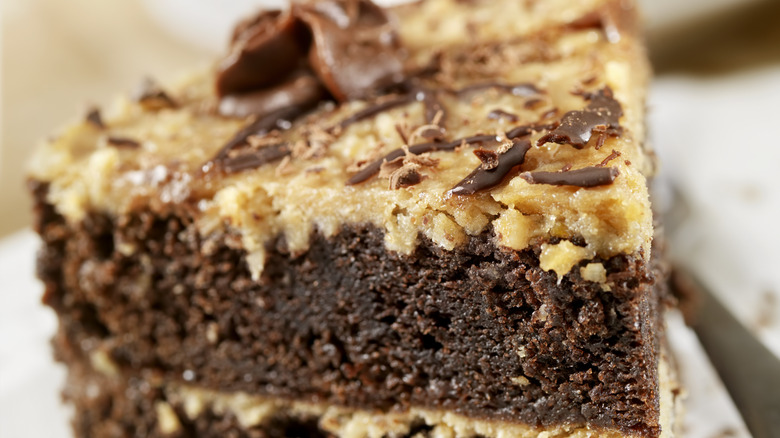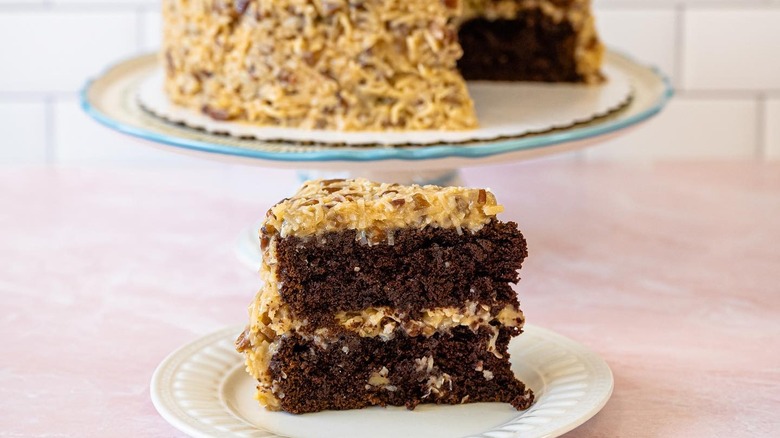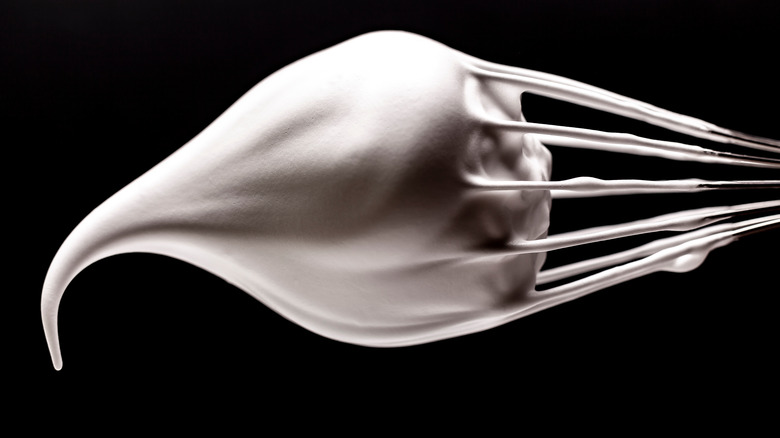What Makes German Chocolate Cake Different From Its Classic Counterpart?
You may have heard that German chocolate cake has nothing to do with Germany, but what sets it apart from traditional chocolate cake? While these chocolatey confections may appear similar at first glance, a closer examination reveals distinct flavors, contrasting textures, and an intriguing history.
Although German chocolate cake and classic chocolate cake share a chocolatey foundation, it's the choice of chocolate and the coconut-pecan frosting that set the German version apart. German chocolate cake uses a particular kind of baking chocolate as its base, one which has a milder, sweeter profile thanks in part to lecithin, a fatty substance derived from egg yolks. In contrast, classic chocolate cake recipes often use cocoa powder or darker chocolate for a richer, more intense flavor.
Another hallmark of German chocolate cake is the signature coconut-pecan frosting. It features a blend of shredded coconut and chopped pecans mixed into a thick, caramel-like, gooey-sweet sauce made from evaporated milk, sugar, and egg yolks. The frosting's unique texture and flavor set it apart from the traditional chocolate ganache or buttercream for classic chocolate cakes. Most pastry chefs will also slather it in between the cake layers for an extra moist end product.
Additionally, German chocolate cakes are often beautifully decorated with additional pecans and coconut on top of the frosting, providing a visual cue to the unique ingredients within. Classic chocolate cakes, meanwhile, are generally frosted simply around the exterior and may or may not feature extra adornments.
So, it's not German?
Despite its name, German chocolate cake does not have German roots. Its origin can be traced back to the United States in the mid-20th century.
The cake is named after Samuel German, an American chocolate maker. In 1852, German developed a type of mild dark baking chocolate called Baker's German's Sweet Chocolate. The name "German's" was attributed to him, and it was intended to differentiate this specific chocolate from other baking chocolates available at the time.
The recipe for German chocolate cake as we know it today became popular after it was featured in a 1957 issue of the Dallas Morning News. Mrs. George Clay is credited with having submitted the recipe titled German's Chocolate Cake. The dessert caught on across the United States, and the moniker was eventually shortened. Over time, it has grown into a beloved American dessert despite its somewhat misleading name.
Tips for a truly mouthwatering German chocolate cake
Now that you know how this cake differs from its classic counterpart (as well as the origins of the decadent dessert), you may be interested in how to make German chocolate cake like a pro. It starts with the right kind of flour. Using cake flour instead of all-purpose flour ensures a light and airy consistency thanks to the lower protein content.
Next, it's important to get the chocolate melting for the batter just right. The double boiler method is preferred because it offers precise control over the melting process, helping to avoid common pitfalls like overheating or burning the chocolate. In a double boiler setup, the chocolate is placed in a heatproof bowl over a pot of simmering water. This indirect heat ensures the chocolate melts gently and evenly, preventing it from overheating and seizing.
Finally, another texture and consistency tip for a perfectly fluffy crumb is to beat the egg whites to stiff peaks. Stiffly beaten egg whites act as a leavening agent that traps air bubbles, which expand during baking. This is particularly important for German chocolate cake, as its characteristic mild and light chocolate base relies on this lightness to balance the rich and dense coconut-pecan frosting.


